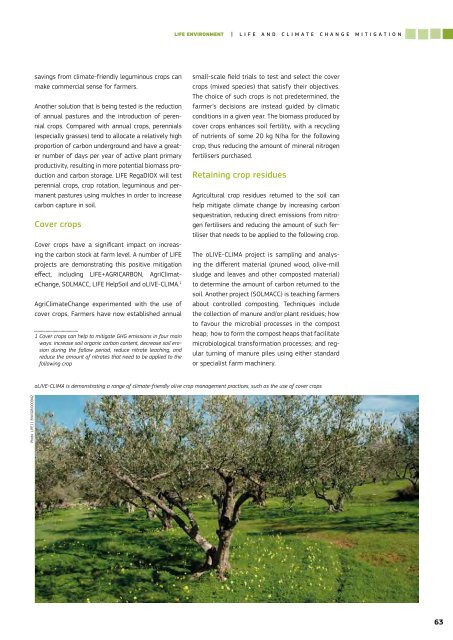You also want an ePaper? Increase the reach of your titles
YUMPU automatically turns print PDFs into web optimized ePapers that Google loves.
LIFE ENVIRONMENT |LIFE and Climate CHANGE mitigationsavings from climate-friendly leguminous crops canmake commercial sense for farmers.Another solution that is being tested is the reductionof annual pastures and the introduction of perennialcrops. Compared with annual crops, perennials(especially grasses) tend to allocate a relatively highproportion of carbon underground and have a greaternumber of days per year of active plant primaryproductivity, resulting in more potential biomass productionand carbon storage. LIFE RegaDIOX will testperennial crops, crop rotation, leguminous and permanentpastures using mulches in order to increasecarbon capture in soil.Cover cropsCover crops have a significant impact on increasingthe carbon stock at farm level. A number of LIFEprojects are demonstrating this positive mitigationeffect, including LIFE+AGRICARBON, AgriClimateChange,SOLMACC, LIFE HelpSoil and oLIVE-CLIMA. 1AgriClimateChange experimented with the use ofcover crops. Farmers have now established annual1 Cover crops can help to mitigate GHG emissions in four mainways: increase soil organic carbon content, decrease soil erosionduring the fallow period, reduce nitrate leaching, andreduce the amount of nitrates that need to be applied to thefollowing cropsmall-scale field trials to test and select the covercrops (mixed species) that satisfy their objectives.The choice of such crops is not predetermined, thefarmer’s decisions are instead guided by climaticconditions in a given year. The biomass produced bycover crops enhances soil fertility, with a recyclingof nutrients of some 20 kg N/ha for the followingcrop, thus reducing the amount of mineral nitrogenfertilisers purchased.Retaining crop residuesAgricultural crop residues returned to the soil canhelp mitigate climate change by increasing carbonsequestration, reducing direct emissions from nitrogenfertilisers and reducing the amount of such fertiliserthat needs to be applied to the following crop.The oLIVE-CLIMA project is sampling and analysingthe different material (pruned wood, olive-millsludge and leaves and other composted material)to determine the amount of carbon returned to thesoil. Another project (SOLMACC) is teaching farmersabout controlled composting. Techniques includethe collection of manure and/or plant residues; howto favour the microbial processes in the compostheap; how to form the compost heaps that facilitatemicrobiological transformation processes; and regularturning of manure piles using either standardor specialist farm machinery.oLIVE-CLIMA is demonstrating a range of climate-friendly olive crop management practices, such as the use of cover cropsPhoto: LIFE11 ENV/GR/00094263


